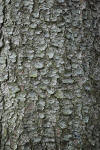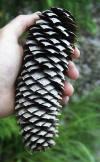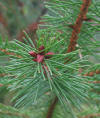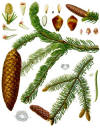WILD
FOODIES' HOME PAGE
PLANT PROFILE LIST
NAME: Spruce
SPECIES / FAMILY: Picea Abies / Pinaceae
OTHER COMMON NAME(S): Norway Spruce
CONDITIONS:
sun-partial shade
|
PARTS: |
EDIBLE |
TASTE |
RAW/COOK |
SEASON |
|
All |
|
|
|
|
|
Shoots |
|
|
|
|
|
Leaves/Needles |
|
RAW/COOK |
Spring |
|
|
Stalk/Stem |
|
|
|
|
|
Buds |
||||
|
Flowers |
|
|
COOK |
|
|
Fruits |
|
|
|
|
|
Pods |
|
|||
|
Seeds |
|
|
|
|
|
Nuts |
|
|
|
|
|
Roots |
|
|
|
|
|
Bark |
|
|
COOK |
|
|
Sap |
|
|
COOK |
|
PORTION: small
COMMENT: Young needles (tips). Flower. Inner bark; Seed. Young male catkins - raw or cooked. Used as a flavouring. Immature female cones - cooked. The central portion, when roasted, is sweet and syrupy. Inner bark - dried, ground into a powder and used as a thickener in soups etc or added to cereals when making bread. Seed - raw. Rich in oil and with a pleasant slightly resinous flavour, but very small. These tips are also used in making spruce beer.(1) Gum made from the hard resin (sap or pitch), not soft resin. There was a time in America when you could buy spruce gum in almost any store, like other kinds of gum today. It was the first gum sold in America. See below for how to prepare.(2)
CAUTION:
NUTRITION/MEDICINAL: Antibiotic; Antiseptic; Balsamic; Expectorant; Poultice; Sedative. The buds, leaves and resin are antibiotic, antiseptic, balsamic, expectorant, sedative. A pitch, or resin, obtained from the trunk is rubefacient and stimulant. It is used externally in plasters etc for its healing and antiseptic properties. A poultice of the sap or gum has been used in the treatment of boil and abscess pain.(1)
LOOK-A-LIKES:
POISONOUS LOOK-A-LIKES: Yew Bush shaped like a tree - https://en.wikipedia.org/wiki/Taxus
OTHER USES: Adhesive; Essential; Pitch; Shelterbelt; Tannin; Varnish; Wood.(1) The tree is a source of pitch (Burgundy pitch) and turpentine (Jura turpentine). Burgundy pitch is used as a varnish and in medicinal plasters. It is a strong adhesive. The turpentine is a waterproofer and wood preservative. They are obtained by incisions in the trunk, the resin is scraped out some months later. An essential oil from the leaves is used in perfumery. The seed contains 30% of a fatty oil, this is used in the production of a varnish. The bark contains some tannin. Both the bark and bark extract have been widely used in Europe as a source of tannin.(1)
SOURCE LINKS (may include nutritional and medicinal info, plus other uses):
- https://pfaf.org/user/Plant.aspx?LatinName=picea+abies
- http://www.eattheweeds.com/a-pitch-for-spruce-gum (how to make spruce gum)
- https://en.wikipedia.org/wiki/Picea_abies
- https://commons.wikimedia.org/wiki/Picea_abies (great photos)
- https://www.nutriplanet.org/2014/05/5-reasons-to-eat-spruce-tips-8-ways-to-use-them
- https://www.nutriplanet.org/2017/06/oil-free-pesto-spruce-tips
- https://food52.com/blog/10454-how-to-cook-with-spruce-tips-plus-a-wild-lemony-pilaf
- http://www.laurieconstantino.com/how-to-harvest-spruce-tips-with-recipes-for-using-spruce-tips-or-pine-tips-or-fir-tips
- https://www.wellpreserved.ca/pickled-spruce-tips-recipe
- http://wildfoodsandmedicines.com/fir-hemlock-and-spruce-tips
- https://www.npr.org/sections/thesalt/2013/01/04/168561089/dont-waste-that-christmas-tree-turn-it-into-spruce-beer
- https://www.npr.org/sections/thesalt/2014/01/19/262793911/cooking-with-conifers-yes-it-s-a-thing (recipes)




